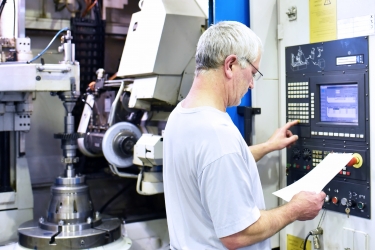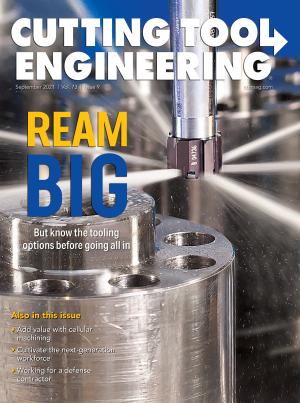The cutting tool industry is dealing with the very real challenge of an aging workforce. Baby boomers, the people in our industry with the most institutional knowledge and skills, have been retiring at a rapid rate. According to a January 2020 report from the U.S. Bureau of Labor Statistics, the median age of workers in our industry was about 49 — and that was almost two years ago, before the pandemic. We need to recruit, train and retain a lot of young people.
Compared with other industries, few young people choose to join our industry. Our talent gap quickly could worsen and result in a serious shortage of many critical skills. However, the more progressive that our industry becomes, the more success we will have attracting younger employees in every discipline.
Appealing to engineers is particularly problematic. Colleges and universities promote four-year engineering programs with the promise of working with organizations like NASA or in high-tech, with graduates destined to become creative designers and engineers who have many flashy opportunities. The reality is that graduates enter the
workforce and realize that there are not enough of those glamorous, high-level, exciting design/engineering jobs. But there are opportunities — plenty of them — in manufacturing industries like cutting tools.
Young engineers who consider other manufacturing industry segments, including automotive and tier one suppliers, will look to cutting tools if we make the environment attractive.

Baby boomers, the people in the industry with the most institutional knowledge and skills, have been retiring at a rapid rate.
Something missing from our business is an internship or apprenticeship program. I don’t mean just the traditional trade segments — apprentice, journeyman and master — but a cross-discipline approach involving engineering, sales and marketing. Having a true career path for all the talent in our business would make it much more enticing. Attracting young workers in every discipline is important to make our industry progressive and aspirational. The shortage of engineering talent is reflected in the other disciplines that are critical to our industry, including sales and skilled trades.
I look forward to the day, not long from now, when young engineers, machinists, salespeople and marketers envy their friends who work at ARCH Cutting Tools. We will foster such word-of-mouth among prospective personnel. This is a very tribal, grassroots but effective approach to develop talent in our business.
The aging workforce causes a lot of risk for organizations. It’s essential to manage the transfer of knowledge from senior employees to new ones and stay engaged while recruits work through the transfer and become comfortable with their responsibilities.
Surviving Adversity and Recruiting Through It
Since I’ve been in the business, we’ve experienced significant downturns. There have been situations in which it would’ve been easier to normalize profitability by cutting the workforce than by making other changes. This is perceived as the quickest way to rationalize the bottom line.
But what actually happens is that the highest-compensated individuals, the ones who have been around the longest and have the most knowledge, experience and skills, often are lost. Even if those people are laid off temporarily, they tend not to come back.
When you have a big financial dip, it’s prudent to protect your talent — not just the most experienced staff but the “middle talent.” These are the workers who know enough that they don’t need to start from square one, but they’re not ready to take on the full responsibilities of a senior employee.
Besides the question of why to work in the cutting tool industry, I think that the shortage of talent is about the allure of corporate work. Would I want to work at a company that has a lot of bureaucracy and a system that may not value me? From a cultural perspective, that situation must change. ARCH Cutting Tools’ legacy culture works to our
advantage in that respect. We have progressive leaders who embrace flexibility. Throughout our organization, managers create an environment that promotes an entrepreneurial approach to work.
Attracting the Right Workers
There’s been a paradigm shift. In the past, when you interviewed for a job, you interviewed with the organization. What can this business do for me as an individual contributor? What’s the pay? What are the benefits? Interest now is moving toward the quality of life. The concept of work/life balance is important to the next-generation workforce. It wants empowerment, flexible working hours and the ability to pursue individual interests. If you typically stick young, talented people behind a desk, that doesn’t motivate them.
If our industry is going to attract younger workers, we need to think like that generation and pursue it the way that it wants to be pursued. That’s because the success of a company depends on the success of employees.
When a culture is established that involves camaraderie and allows personnel to efficiently move through the organization via opportunities and promotions, modern talent will see value there. The new generation of workers has a reputation as job hoppers, but I think that’s an oversimplification. I believe they’re looking for ongoing challenges and opportunities to try new things. You can create an attractive environment for that. Give chances for employees to keep moving within the organization, and show that there’s room for personal growth.
Selecting the right people is near and dear to my heart. Traditionally, we don’t measure candidates for their cultural fit — we measure them by what we see on paper. But consider this: Maybe if they don’t have all the skills or experience they need, that can be learned. If they are open-minded and flexible and can work independently, you can develop them. However, if you bring in someone who looks to possess the appropriate skills but can’t work within the culture, you’re doomed to failure.
What matters is the results of the workforce. You may make the work attractive, such as being flexible about working from home, as long as results are achieved. Employees can focus on what they need to accomplish, not how many hours they work.
Investing in a workforce is very beneficial. Again, results are what matters. Workers will take ownership and deliver. They’ll adopt an entrepreneurial approach and treat their jobs like the business is their own. That’s good for our company.
ARCH Cutting Tools is ahead of the curve. We’re faster, nimbler and more flexible, and we are becoming more enlightened in how we approach our business, as well as our relationships with customers and partners. We’re also strategically building the right workforce for the future. Our goal is to thoroughly prepare internally to succeed externally as a progressive 21st century business.


